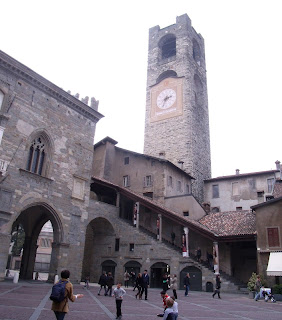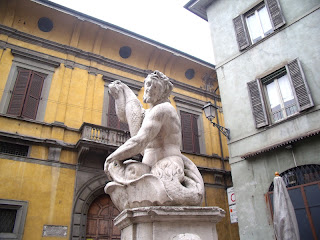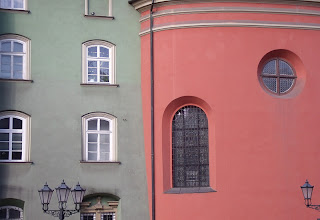Napoleon was here too! Let’s get that out of the way first. He turned up, annexed the city and for no reason I could discover knocked down the substantial church attached to the largest monastery in the area. (He also knocked down a church in Venice
Mind you I would not mind whitewashing a few of the Baroque interiors. The most offensive is in the Cappella Colleoni a 14th century attachment to the Basilica of Santa Maria Maggiore. As wealthy men will do, they want to leave something significant by which people will remember them. Often this was an offering or an attempt to bribe the church and even higher authorities. In this instance Captain Colleoni was not unusually bad; but he fell in with the tradition of leaving something to exalt God; and himself. However he did rather tempt fate, as he knocked down a substantial portion of the church to make room for his burial chapel. It is a knockout. Perpendicular Gothic with a rose window, it is covered in marble deploying polychromatic patterns. It shoots up skyward in exuberance and is a highlight of the visit. However; inside some mutt decided, much later, to let lose a painter to produce jarring baroque paintings that come as a real shock to the system. They are by a master, Tiepelo; I would nevertheless whitewash them, then take the bucket and brush across town to several other monstrous interiors.
Donizetti lived and wrote his operas for the local house. Pope John XXIII was born close by and returned to the city from Rome to assist the bishop of Bergamo Vatican
This is a city on three geographic levels with two funiculars, some distance from one another, that connect the elements of the city. Down on the plain sits the more modern city: though there are some ancient stranded buildings and a large area of 19th century city planning. On this short visit we confined ourselves to the two upper parts of the city.
The weather was not kind to us; but neither was it as cruel as the BBC site predicted. We should have had three days of solid rain. In the event, the heavy skies mainly rolled over us without dumping enough to raise an umbrella; on our last day though we sat in a café to escape the worst of a substantial and extended thunder storm. The historic areas are very well preserved. The city has been fortunate, or wise, to preserve so much that is ancient. The back streets were very quiet and it was a pleasure to see what lay round a corner, or down some steps. The higgledy piggldy melee is a treat to walk through.
This is quite a wealthy city, there are a lot of very large and well maintained houses. The locals do not display the style of Milan or Bologna, they do not provide a parade of designer clothes as is evident in those two other cities. They do however, and typically, take their food very seriously. The thinking about food clearly feeds into Italian identity. It seems that no patrotic Italian would bother with the food of another country, well....another region. Wherever you are in the country it is difficult to find food from elsewhere. If you can’t stomach tomato or cheese; pack your bag with Mars Bars or you will go hungry.
Here the specialities of the area are not found in the bog standard Italian restaurant in GB. I saw one mention each of spaghetti carbonara and of lasagna. The real obsession here, like potatoes to the Irish, is polenta. It comes in a variety of textures, wall paper paste, porridge or marsh mallow. Any of the ways, boiled, fried or hidden under cheese, it is pretty tasteless, but is a firm staple here. There is even a polenta fast food outlet across the square from the top of the lower funicular. We tried the polenta a couple of times then decided to avoid it. On one occasion it arrived as part of a spectacular main course for two consisting of roast pork, rabbit and a large piece of lamb. This latter looked like a ship being tossed around in a frozen mountainous sea of orange polenta. We gazed at a menu entry of ‘donkey, polenta and rocket. OK; hold the donkey, forget the polenta and I will go for the rocket. Actually; never mind, let’s move along.
The ‘P’ stuff is ever adaptable and is also made into sweet gunk, sold in bowler hat shape to fit the smallest baby or the largest head of any adult. But once we weeded out the noxious stuff; we enjoyed many dishes such as the ravioli with bacon in a very light and sparing sauce, the ragouts, the wonderful breadsalso the ‘lard’ which is very thinly cut pork taken from just under the skin, sweet fat to clog the arteries.
This was not so much a hit and run visit: more a slow slouch with much pause for coffee and to read. We needed a chill out and it was just the ticket. We deliberately left much undone. Once on the plane it takes about an hour and three quarters and that equates to my commute to London
Cappella Colleoni































































